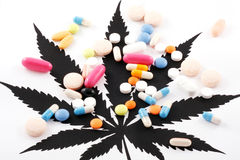
Professionals concerned with delivering sound medical treatment to those in pain, or suffering from other conditions treated successfully with Medical Marijuana, should be the most vocal in demanding the ability to better test its cause and effects.
One of the significant benefits of the Supplement Health and Education Act of 1994 (DSHEA) was the response from scientists in researching why supplements worked and what combinations and dosages brought the best results. Prior to the DSHEA legislation, supplement dosage and benefits information were largely anecdotal. Similarly, moving from anecdotal Cannabis treatments to proper testing of Medical Marijuana, using scientifically verified components, strains, and dosages will only enhance the results of those currently using Marijuana for medicinal purposes.
Unfortunately, this is impossible while both the DEA and FDA continue to classify Cannabis as a Schedule 1 narcotic—meaning it has zero medicinal benefit. Clearly, there is more than enough evidence to have had this schedule changed decades ago.
Drug Scheduling
Drugs, substances, and certain chemicals used to make drugs are classified into five (5) distinct categories or schedules depending upon the drug’s acceptable medical use and the drug’s abuse or dependency potential. The abuse rate is a determinate factor in the scheduling of the drug; for example, Schedule I drugs have a high potential for abuse and the potential to create severe psychological and/or physical dependence. As the drug schedule changes– Schedule II, Schedule III, etc., so does the abuse potential– Schedule V drugs represents the least potential for abuse.
A Listing of drugs and their schedule are located at Controlled Substance Act (CSA) Scheduling, or CSA Scheduling, by Alphabetical Order.

Schedule I
Schedule I drugs, substances, or chemicals are defined as drugs with no currently accepted medical use and a high potential for abuse. Some examples of Schedule I drugs are: heroin, lysergic acid diethylamide (LSD), marijuana (cannabis), 3,4-methylenedioxymethamphetamine (ecstasy), methaqualone, and peyote
Schedule II
Schedule II drugs, substances, or chemicals are defined as drugs with a high potential for abuse, with use potentially leading to severe psychological or physical dependence. These drugs are also considered dangerous. Some examples of Schedule II drugs are:
Combination products with less than 15 milligrams of hydrocodone per dosage unit (Vicodin), cocaine, methamphetamine, methadone, hydromorphone (Dilaudid), meperidine (Demerol), oxycodone (OxyContin), fentanyl, Dexedrine, Adderall, and Ritalin
Schedule III
Schedule III drugs, substances, or chemicals are defined as drugs with a moderate to low potential for physical and psychological dependence. Schedule III drugs abuse potential is less than Schedule I and Schedule II drugs but more than Schedule IV. Some examples of Schedule III drugs are: Products containing less than 90 milligrams of codeine per dosage unit (Tylenol with codeine), ketamine, anabolic steroids, testosterone
Schedule IV
Schedule IV drugs, substances, or chemicals are defined as drugs with a low potential for abuse and low risk of dependence. Some examples of Schedule IV drugs are:
Xanax, Soma, Darvon, Darvocet, Valium, Ativan, Talwin, Ambien, Tramadol
Schedule V
Schedule V drugs, substances, or chemicals are defined as drugs with lower potential for abuse than Schedule IV and consist of preparations containing limited quantities of certain narcotics. Schedule V drugs are generally used for antidiarrheal, antitussive, and analgesic purposes. Some examples of Schedule V drugs are: Cough preparations with less than 200 milligrams of codeine or per 100 milliliters (Robitussin AC), Lomotil, Motofen, Lyrica, Parepectolin
Current Status of Marijuana In The World
Currently, under both U.S. law and global agreements, Marijuana sits in the most restrictive category of Schedule I. Domestically that means it is not available for formal prescriptions and research on its effects is heavily restricted prohibiting proper testing of Medical Marijuana. Globally, it means that nations that signed onto drug treaties are not supposed to legalize Cannabis.
Marijuana itself has never been subject to formal review since first being placed in Schedule I of the international agreement enacted in 1961.
However, in a VERY quiet notification, the FDA requested public comments earlier this year with a due date of April 23. The process seems to have been designed to limit it to those within the pharmaceutical community (including the AMA) by virtue of limited communication channels.

In March (2018), UN Secretary-General António Guterres used a speech before the body’s narcotics commission to tout the drug decriminalization law his home country of Portugal enacted when he was prime minister.
Within the same month however, the UN’s drug enforcement body issued a report warning countries not to legalize Marijuana.
According to the FDA, they have “an important role to play in supporting scientific research into the medical uses of marijuana and its constituents in scientifically valid investigations as part of the agency’s drug review and approval process. As a part of this role, the FDA supports those in the medical research community who intend to study marijuana.”
The FDA also states that it “supports research into the medical use of marijuana and its constituents.” Yet such research is done only on “research-grade product” approved by the National Institutes of Health and provided by the University of Mississippi.
This is ineffective for those currently treating individuals at the state level for two reasons. First, they are not using the “research-grade” Marijuana being tested, and second, the only companies allowed to test with the University of Mississippi are pharmaceutical companies.
Pharmaceutical companies are motivated by profits, and their profits come from patentable products—hence their opposition to states’ legalization of Medical Marijuana and accompanying proper testing of Medical Marijuana.
As the legalization of Medical Marijuana battlegrounds has shifted from state to state, the most frequent and consistent attacks from opponents have been around lack of testing and the variety of plants being grown.
These were the same attacks around the Supplement Health and Education Act of 1994 (DSHEA), which proved unfounded as research, and resulting standards, blossomed after the legislation passed.
While CURE Initiative fully supports and endorses accurate and objective testing, it has stated repeatedly that opposing Medical Marijuana for lack of testing, but doing nothing to pave the way for more proper testing of Medical Marijuana is both hypocritical and duplicitous.
Furthermore, if concerns that there are potentially dangerous compounds in the varieties of Marijuana being distributed are legitimate, the sooner those compounds are scientifically tested and verified, the safer existing customers will be.
Those proclaiming motivations of protecting consumers should be in the frontlines petitioning federal agencies for the ability to test products being used in the various states that have legalized Medical Marijuana. Not surprisingly, we don’t see them there—further indication that they are motivated by profit, not driven to deliver safety and wellness.
Another legitimate concern is that in rescheduling Marijuana, pharmaceuticals will argue that only they should be allowed access to Marijuana as a medical product. In doing so, they would succeed in limiting the value of the plant to what they can patent. This would seriously impact the wellness of those currently benefiting from whole plant medications.

In fact, the Food and Drug Administration (“FDA”) has already approved Epidiolex, G.W. Pharma’s oral cannabidiol (“CBD”) solution for the treatment of seizures associated with Lennox-Gastaut and Dravet syndrome.
On October 1st, the Drug Enforcement Administration (“DEA”) issued a Final Order placing “FDA-approved drugs that contain CBD derived from cannabis and no more than 0.1 percent tetrahydrocannabinols” in Schedule V of the Controlled Substances Act (“CSA”).
In taking this action, DEA decided to limit the rescheduling of CBD to a specific (pharma) formulation of an FDA-approved drug product and re-emphasized that except for this specific formulation, CBD remains a Schedule I substance.
States that have granted their citizens access to the healing benefits of Marijuana need to safeguard this access by actively participating in the rescheduling process. Legalizing Marijuana without lobbying for proper testing of Medical Marijuana exposes their citizens to potential harm or reduced benefits from their treatments.



